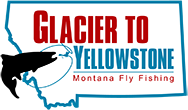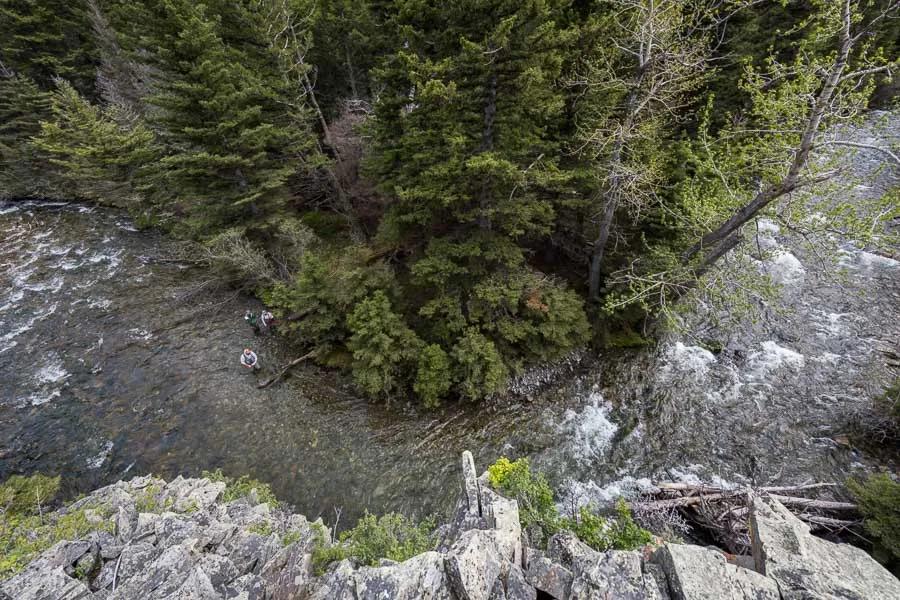Much of the prairie lands in the Augusta and Choteau area did not attract a large number of homesteaders after it was opened in 1862. Once the prime river-bottom land was claimed, the remaining lands were dry and wind-swept. Adding to this was the area's bleak and chilling winters. Typical government homestead offerings of 160 or 320 acres could not sustain a small rancher or farmer without irrigation water. The first irrigation project, completed in 1918, brought renewed interest to the area. The Bureau of Reclamation concluded that, in order to bring prosperity to the area, the Sun River would need to be dammed. With the completion of the Gibson Reservoir in 1929, the area enticed new settlers to the region. Today Gibson Reservoir provides boating and fishing recreation to residents and visitors.
More importantly, it is the trailhead for the North Fork of the Sun River and the South Fork of the Sun River, as well as the majestic Bob Mar-shall Wilderness. Although some fair to poor fishing may be experienced across the grasslands that the Sun River traverses, for the most part the river is restricted by private property.
Gibson Reservoir
Gibson Reservoir offers a boat launch, Mortimer Gulch Campground, and a horse facility. Just above the boat launch, Trail 201 leads seven miles to the head of the lake. For day hikers wishing to fish the North Fork of the Sun River, plan on a three-hour hike. Although the trail is not arduous and mostly level, horse people need to be forewarned that the trail follows along the contours of the lake, and for about 30 minutes of travel time the trail is chiseled out of solid rock, high above the lake's waters, often with little room to pass or maneuver.
One of the first scenic areas to camp on the lake may be reached in just a little more than an hour, and it offers both shoreline and shade. At the head of the lake, the trail forks to the right up over a saddle and down into the North Fork drainage. Trail 201 continues to the confluence of the North Fork and the South Fork, approximately two miles.
Trail 201 ascends the north side of the valley mountain-side cresting at a saddle, which offers a splendid view of the South Fork drainage. Hikers pass through two gates as they descend down through aspen groves and the early summer abundance of wildflowers. From mid-June through early July, plan on seeing a host of wildflowers representing the color palate. On my trip on June 11, 2000, I noted wild roses, sunflowers, orchids, iris, Indian Paint Brush, lupine, and my favorite, the shooting star. I wish I could take photographs of all the beautiful flowers that I am sure I had never seen before, but my lead donkey, Buddy, becomes impatient and pushes me when I pause, and Banjo also usually resorts to some impatient mischief when I stop.
Although I did not travel very far inside the Bob Marshall Wilderness designation, the river beckons with promise. I would estimate that I walked nine miles before I viewed the North Fork of the Sun River. Camped on a bluff overlooking the river, I fished for only 30 minutes before I was drenched with a chilling rainstorm. Although I caught one small cutthroat, it was difficult fishing during the silted runoff. Nonetheless, the North Fork is considered good fishing for nice-sized cutthroats. The next morning I broke camp and headed back to meet Trail 201 to the South Fork of the Sun.
South Fork of the Sun River
Trail 201 continues following the lake shore past the narrow cliffs that back up the North Fork and the South Fork. At the head of the lake the North Fork tumbles past the K-Bar-L Guest Ranch. Relocated in 1927 with the construction of the Gibson Dam, the ranch was originally patented in the 1880s under Soldier's Script. The ranch, supplied with natural energy systems, offers a traditional guest ranch in the heart of a wilderness. Owned and managed by third- and fourth-generation members of the Klick family, the ranch is only reached by boat or by trail. Passing through the Klick Ranch, hikers will enter the Bob Marshall Wilderness about a mile above the bridge over the North Fork and just above a series of rapids. From this juncture the trail splits. The lower trail is the low-water trail and it fords the river within the first mile and winds its way up the South Fork to Benchmark. I camped where the two trails split. The upper trail circumvents the canyon on its way 14 miles to Benchmark. At this same junction a third trail leads eight miles to Bear Lake, which offers excellent fishing for 10-inch cutthroats.
The best fishing in this area is just up from the Klick Ranch, where the South Fork of the Sun backs up to the cascading rapids. During the spring when the water is high, boaters motor the seven miles right up to the confluence and drop anchor. Fishing mostly with bait and roe, they catch a lot of small cutthroats that mingle around just below the rapids. Later when the water drops, the boaters have to hike up the trail a little ways. Having been "skunked" due to the high and roiled water above the falls, that evening I couldn't resist moving down to the slower water, where all the boats had been anchored. (I dare say many of you, too, would succumb to this fish-pond mentality if you had hiked upwards of 15 miles in two days and found yourself cheerless having caught only one dink.)
I attached an "Oscar-the-Grouch" look-alike. It was bright green, two inches long, had big bulbous eyes, as well as yellow rubber legs. Well, I thought, that should be heavy enough to pull down my San Juan worm to the bottom. To my surprise, on the very first cast, I caught my first 10-inch cutthroat on this frightful Woolly Bugger. On the third cast I caught another 10-incher on the San Juan. In 30 minutes I had caught six cutthroats and one grayling. Off in the distance I heard the supper bell on the Klink Ranch. I knew that it did not toll for me, and that the guests were going to sit down to a delicious ranch meal, but one mile away in a small meadow next to the river, I was content. I look forward to returning.
Before I left, my camp was inspected by a game warden. I queried him about the fishing reports that the South Fork was only fair fishing above the Klick Ranch. He had no insights, although he con-ceded that he would only describe the South Fork as fair, unlike the North Fork, which he rated good to excellent. He did acknowledge that the West Fork of the South Fork of the Sun offered good fishing up in the meadow section.
I must say that my donkeys were fairly well-behaved the first two days, but on our return Banjo started acting up long before I got to the granite cliff section. This was the first trip handling both donkeys by myself. I tied Banjo's lead rope to Buddy's pack with a slip-knot. Each time we came to a rivulet trickling across the trail, Buddy would flair his nostrils and leap forward. Right behind him Banjo would react by jumping back. What a mess this created. A number of times the rope did not slip, and I had a tug-of-war between the two asses. Finally, I gave up and completely unhooked Banjo and let him walk as a free agent. When I got to the cliff section, I fretted about what to do with two critters. The trail is literally blasted out of sheer rock high above the lake, not to mention the fact that it is very narrow in places. Would Banjo behave better and create less tension if we passed someone on the trail and he was free to freak-out or hug close to Buddy and myself? Or would I be able to keep control of him if I tied him to Buddy with a serious knot? Every time I came to a blind corner, I nervously called out and listened for a reply. Gradually, my confidence grew as I gingerly led these two donkeys closer to the end of the cliff section.
The trail in one spot descended straight down to the water's edge and another blind corner. We rounded the corner and headed straight up the cliff again. Nearing the crest about 80 yards away, I could see the trail was vacant for another 100 yards. I breathed a sight of relief. Suddenly the pressure of the climb proved too much for Buddy, and he cut wind so loud he shattered Banjo's poking complacency. Head to butt, naturally Banjo jumped backwards. On hearing loose rock dropping down to the water below, Buddy panicked and lunged forward. Banjo, overwhelmed with fear, naturally followed his flight instinct, spun around and galloped back down the trail hell-bent for leather. I yelled, but it was no use. I prayed that no one would be on the trail behind us, as Banjo bucked and kicked around the blind corner. By the time I found a root on the side of the cliff to tie up Buddy, Banjo came charging around the trail again. I was quite amazed that all of his packs were still securely tied. He ran up to me and buried his head in my chest as if to say, I'm sorry. I wasn't polite in sharing with him the frustration and anxiety he had caused me. The cute donkey routine just didn't cut it. Ah, dear reader, I know by now you must by thinking to yourself, is this guy reckless, irresponsible, crazy, foolhardy, or just experiencing beginner's luck? I, too, am beginning to raise those questions.
River description by David Archer

